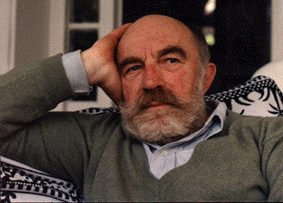
back to Liquid Architecture
4 site
LIQUID
ARCHITECTURE 5
about
LA | LA5 program | LA5
bios | articles/interviews | sound/video
files
| Archival: LA4 site
Bernard Parmegiani
A Multi Speaker Diffusion Presentation of his life's work
Sunday July 13, 7.00pm
$10/$8 Concession
Venue: RMIT Storey Hall
Curator: Philip Samartzis
In 1959 Bernard Parmegiani joins the GRM (Le Groupe de Recherches Musicales) where, under the direction of Pierre Schaeffer, he undertakes a two year course in electroacoustic music.
In 1962, he composes his first piece, Violostries, which becomes the subject of a choreography by the Contemporary Theatre of Amiens directed by Jacques-Albert Cartier.
Pierre Schaeffer entrusts to him the responsibility for the Music-Image sector of GRM. He enters into many successful relationships with film-makers and composes the music for films by R. Lapoujade, P. Foldmès, P. Kamler, V Borowczyck, P. Kast, J Baratier, P. Kassovitz. Within the framework of a fixed time, measured and imposed by the duration of the image, the contents of which he is not the author of, he still finds much musical freedom.
He extends his research to include video art during a study trip in the United States, carried out thanks to a bursury from the Ministry for the Culture. Upon his return, he produces three music videos: The Eye listens (1973), Jeux of artifices (1979) for the Research centre of the ORTF and the transparent Screen (1973) in Cologne with the WDR under invitation.
Interested in the combination of the techniques of jazz improvisation and electroacoustic music, he works with various free jazz groups: J-L Chautemps, B Vitet, Mr. Portal, and London pop group The Third Ear Band.
In addition to musics intended for radio, television, cinema, theatre and choreography, with some impressive credits along the way (France-Culture, France-Music, Antenne 2, Aéroport of Roissy...), he composes about fifty musical pieces, the majority of which are acousmatic, with some instrumentals, others being musical actions where interpreters intervene, actors, instrumentalists.
His works have been programmed in many international festivals and concerts and have won many a prize: Prize of the Academy of the French Disc (1979); Prize of the SACEM (1981); Victories of the Music (1990); Prize "Magister" with the International Contest of Bourges (1991).
Principal works: Violostries (1964), the mobile Moment, Captures transitory (1967-68), the Eye listens (1970), the Hell (according to the Divine Comedy) (1971), to finish some with the capacity of Orphée (1972), De Natura sonorum (1975), the Echo of the mirror (1980), the Creation of the world (1984), Exercisme 1, 2 and 3 (1985-86), This compound (1991), Meanwhile (1992), Sonare (1997).
Discography: The wheel ferris (imaginary Concert, INA C 1000); Of sonorum will natura (INA C 3001); The creation of world (INA C 1002); Violostries, to finish some with the capacity of Orphée, Dedans-dehors, Red-Death, Exercisme 3, this compound, Black Light (double CD INA C 1012-1013); Pop' eclectic (PL 08).
If, with the aid of a few words, I had to pinpoint my musical path since the 1960s, I would find them through works such as Violostries, Capture éphémère or De Natura Sonorum.
The instanteneity of the ephemeral, the mobility or the metamorphosis of the repetitive, the full stop and the new line (compression/expansion): those are the springboards from which, subsequently, my different trips in sound were organised, though I sometimes played truant, forgetting the field of exploration I had set myself, and gleaning on the way a few flowers of budding ideas, which were useful for later works. Thus the areas of exploration broaden out, intersect, are superimposed, get lost and find themselves again, finally forming the author's territory.
With De Natura Sonorum (1975) a second exploratory period began, in which electroacoustic composition became one of the major motives. It also drew its elements from the visual for the realisation of musical actions confronting the image, the text, the voice, action on stage. The Exercismes that followed, also represent compositional research, the aim of which was no longer the confrontation between natural and artificial sound in order to define a "nature" of sounds, but a treatment of psuedo-instrumental sounds (so-called "reference" sounds), distorting it, as it were, to make them topple towards our acoustic language, "unknown language" as some will say.
Translation Mary Pardoe
From the INA-GRM release INA C 1012-1013